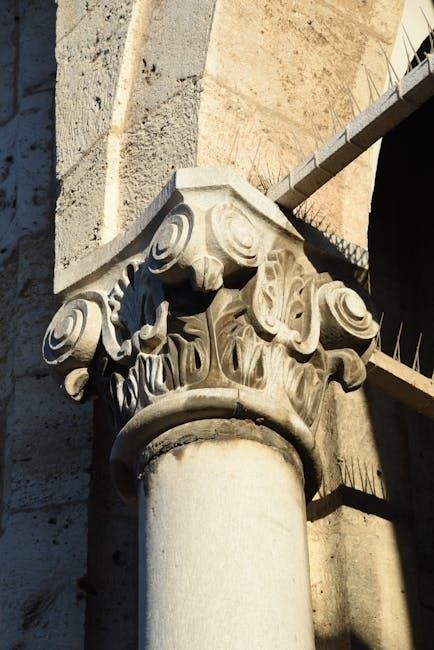The Divine Liturgy‚ a sacred worship service‚ combines Greek and English texts to preserve tradition and accessibility‚ fostering unity among diverse Orthodox communities worldwide․
1․1․ Definition and Significance
The Divine Liturgy is the central act of worship in the Orthodox Church‚ representing a dialogue between God and His people․ It is a sacred service where the priest leads the congregation in prayer‚ hymns‚ and the Eucharistic sacrifice․ The liturgy is often celebrated in both Greek and English to accommodate diverse linguistic traditions․ Its significance lies in its role as a means of spiritual growth‚ fostering unity among believers‚ and commemorating the life‚ death‚ and resurrection of Christ․ The availability of bilingual texts‚ such as Greek-English PDFs‚ ensures accessibility for all worshippers‚ preserving the rich theological and cultural heritage of the liturgy while adapting to modern needs․
1․2․ Historical Context
The Divine Liturgy traces its roots to the early Christian Church‚ evolving over centuries with contributions from prominent figures like St․ John Chrysostom and St․ Basil the Great․ The liturgy reflects the Church’s rich theological and cultural heritage‚ blending biblical traditions with hymnography and sacramental practices․ The Liturgy of St․ John Chrysostom‚ widely used today‚ was formalized in the 5th century‚ emphasizing the Eucharistic sacrifice and communal worship․ Over time‚ translations into English and other languages emerged to accommodate diverse congregations‚ while Greek remained central to its tradition․ This blending of languages ensures the liturgy’s accessibility and continuity‚ preserving its historical essence while adapting to modern multicultural settings․
1․3; Purpose of the Divine Liturgy
The Divine Liturgy serves as the central act of worship in the Orthodox Church‚ fulfilling the command to “worship in spirit and truth․” Its primary purpose is to glorify God‚ express gratitude for His creation and redemption‚ and unite believers in the Body of Christ․ The liturgy culminates in the Eucharistic sacrifice‚ where bread and wine are consecrated into the Body and Blood of Christ‚ offered to the Father for the salvation of all people․ It fosters spiritual growth‚ strengthens communal bonds‚ and prepares the faithful for eternal life․ The bilingual Greek-English PDF ensures accessibility‚ preserving the liturgy’s ancient traditions while making it understandable to modern‚ diverse congregations․

Historical Development of the Divine Liturgy
The Divine Liturgy evolved from early Christian practices‚ influenced by Jewish worship and apostolic traditions․ Over centuries‚ it incorporated elements from various Church Fathers‚ such as St․ Basil and St․ John Chrysostom‚ reflecting theological and cultural developments․ The bilingual Greek-English PDF preserves this rich heritage‚ ensuring accessibility while maintaining liturgical integrity for diverse congregations․
2․1․ Origins of the Liturgy of St․ John Chrysostom
The Divine Liturgy of St․ John Chrysostom traces its origins to the 4th-5th centuries‚ when St․ John Chrysostom‚ a renowned Church Father‚ reformed and streamlined existing liturgical practices․ His contributions emphasized clarity‚ beauty‚ and theological depth‚ creating a structure that remains central to Orthodox worship․ The liturgy reflects his passion for prayer‚ Scripture‚ and community participation‚ blending elements from earlier traditions with his own eloquent prayers․ Over time‚ his liturgy became the standard for the Byzantine Rite‚ celebrated in both Greek and English․ The bilingual Greek-English PDF ensures this timeless worship is accessible to modern congregations while preserving its sacred heritage․
2․2․ Contributions of St․ Basil the Great
St․ Basil the Great‚ a 4th-century Church Father‚ significantly shaped the Divine Liturgy through his liturgical reforms and theological writings․ He structured the prayers and rites‚ ensuring a balanced blend of worship‚ doctrine‚ and spiritual nourishment․ Basil’s emphasis on community and sacramental life influenced the development of the Liturgy of the Faithful and the Eucharistic Canon․ His liturgy became a foundation for later Byzantine practices․ The bilingual Greek-English PDF preserves his contributions‚ making his timeless prayers accessible to modern worshippers while maintaining the richness of tradition․
2․3․ Evolution Over the Centuries
Over the centuries‚ the Divine Liturgy has evolved while maintaining its core theological and spiritual essence․ The liturgical practices adapted to changing cultural and linguistic contexts‚ ensuring the rite remained relevant and accessible․ The integration of Greek and English texts reflects this evolution‚ preserving tradition while engaging modern worshippers․ The development of bilingual resources‚ such as the Greek-English PDF‚ highlights the ongoing effort to bridge linguistic divides․ This adaptation ensures the liturgy’s timeless message continues to resonate across generations and communities‚ fostering unity and understanding among diverse worshippers․
Structure of the Divine Liturgy
The Divine Liturgy is structured into preparatory rites‚ the Liturgy of the Word‚ the Liturgy of the Faithful‚ the Eucharistic Canon‚ and Communion․
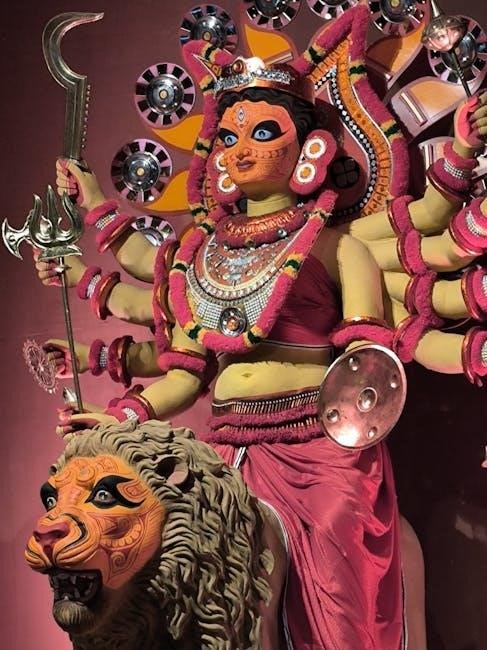
3․1․ Preparatory Rites
The preparatory rites‚ or Prothesis‚ are the initial steps before the Divine Liturgy begins․ The priest prepares the bread and wine‚ symbolizing Christ’s Nativity and burial․ The bread‚ or Prosphora‚ is stamped with a cross‚ and a portion is cut out for communion․ Wine and water are mixed‚ representing Christ’s blood and water․ The congregation also prepares through prayer and reflection‚ ensuring a reverent mindset․ These rites emphasize the liturgy’s sacredness and the need for spiritual readiness․ The preparatory rites bridge the earthly and heavenly realms‚ setting the tone for the divine service․ They are essential for both the clergy and the faithful to enter into the liturgy’s deeper spiritual meaning․
3․2․ Liturgy of the Word
The Liturgy of the Word‚ or Liturgia tou Logou‚ is a central part of the Divine Liturgy․ It begins with prayers and litanies‚ followed by the reading of the Epistle and Gospel․ These readings are taken from the New Testament and are chanted in Greek and often in English‚ ensuring accessibility for all worshippers․ The homily‚ or sermon‚ is delivered by the priest‚ offering insights into the scripture․ Hymns and chants‚ such as the Apositic and Gospel Responses‚ enrich the service․ The Liturgy of the Word emphasizes the importance of scripture and its application to everyday life‚ fostering spiritual growth and unity among the congregation․ This section prepares the faithful to receive the Eucharist‚ deepening their connection to Christ․ The bilingual Greek-English PDF ensures that both languages are honored‚ preserving tradition while accommodating modern diverse communities․ This balance supports the liturgy’s universal appeal and spiritual impact․ By blending ancient practices with contemporary accessibility‚ the Liturgy of the Word remains a vital part of Orthodox worship‚ guiding believers toward a deeper understanding of their faith․ The use of both Greek and English in the PDF reflects the Church’s commitment to unity and inclusivity‚ ensuring that worshippers of all linguistic backgrounds can fully participate and benefit from the liturgy․ This duality enriches the worship experience‚ allowing the Divine Liturgy to resonate with diverse congregations while maintaining its rich theological and cultural heritage․ The Liturgy of the Word serves as a powerful reminder of the enduring relevance of scripture and tradition in the modern world․
3․3․ Liturgy of the Faithful

The Liturgy of the Faithful is the second and most sacred part of the Divine Liturgy․ It begins with the Great Entrance‚ where the priest carries the Holy Gifts to the altar‚ symbolizing Christ’s journey to Golgotha․ The Nicene Creed is recited‚ affirming the faith of the congregation․ The Eucharistic prayers follow‚ invoking the Holy Spirit to consecrate the bread and wine into the Body and Blood of Christ․ The faithful prepare for Communion with prayers of repentance and thanksgiving․ The Greek-English PDF ensures that worshippers can follow the prayers and chants in both languages‚ enhancing participation․ This liturgy emphasizes unity and the sacramental mystery‚ culminating in the distribution of Holy Communion to the baptized faithful․ It is a time of profound spiritual intimacy with God․
3․4․ The Eucharistic Canon
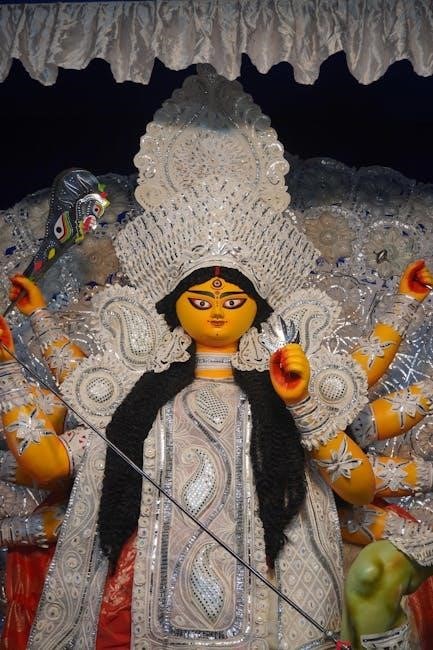
The Eucharistic Canon is the heart of the Divine Liturgy‚ where the bread and wine are consecrated into the Body and Blood of Christ․ It includes the epiclesis and the Words of Institution‚ moments of profound theological significance․ In a Greek-English PDF‚ worshippers can follow the prayers in both languages‚ enhancing their spiritual engagement․ This bilingual approach ensures that the liturgy remains accessible to diverse congregations‚ preserving tradition while accommodating modern linguistic needs․ The Eucharistic Canon serves as a spiritual bridge‚ connecting the faithful across generations and cultures through the sacred mystery of the Eucharist․ It fosters unity and deepens the worship experience․
3․5․ Communion and Dismissal
The communion and dismissal are pivotal moments in the Divine Liturgy‚ marking the culmination of the Eucharistic celebration and the congregation’s sending forth․ In a Greek-English PDF‚ these sections are presented bilingually‚ ensuring that all participants can fully engage with the prayers and hymns․ The communion prayers‚ recited in both languages‚ reinforce the unity of the faithful as they receive the sacred gifts․ The dismissal‚ often chanted with solemnity‚ concludes the service with a final blessing and a call to live out the Gospel in daily life․ This bilingual format bridges linguistic and cultural divides‚ enriching the spiritual experience for diverse congregations and fostering a sense of togetherness․
The Divine Liturgy in Greek and English
The Divine Liturgy in Greek and English provides a bilingual format‚ ensuring accessibility for both Greek and English-speaking congregations‚ fostering unity and understanding during worship․
4․1․ Importance of Bilingual Texts
The use of bilingual texts in the Divine Liturgy‚ such as Greek and English‚ is essential for bridging cultural and linguistic gaps within diverse congregations․ It ensures that both Greek-speaking and English-speaking faithful can fully participate and understand the prayers and hymns․ This format preserves the rich theological and liturgical traditions of the Greek Orthodox Church while making the services accessible to a broader audience․ Bilingual texts also serve as a valuable educational tool‚ allowing younger generations to connect with their heritage and deepen their spiritual engagement․ By maintaining the original Greek alongside accurate English translations‚ the integrity and beauty of the liturgy are upheld for all worshippers․
4․2․ Challenges in Translation
Translating the Divine Liturgy from Greek to English presents several challenges‚ particularly in maintaining theological accuracy and liturgical beauty․ The rich theological terminology and poetic expressions in Greek often lack direct English equivalents‚ requiring careful adaptation․ Cultural and linguistic nuances may not translate seamlessly‚ risking loss of meaning or tone․ Additionally‚ the rhythmic and musical qualities of the original Greek text‚ essential for worship‚ must be preserved in translation․ Balancing fidelity to the original with clarity for English-speaking worshippers is a delicate task․ These challenges highlight the need for skilled translators who deeply understand both languages and the liturgical context․
4․3․ Benefits of a Greek-English PDF
A Greek-English PDF of the Divine Liturgy offers numerous benefits‚ enhancing accessibility and understanding for worshippers․ It allows bilingual congregations to follow the service seamlessly‚ fostering unity and participation․ For those learning Greek or English‚ the side-by-side text aids language acquisition while preserving liturgical traditions․ The PDF format ensures portability and convenience‚ enabling worshippers to access the liturgy on various devices․ Additionally‚ it serves as a valuable educational resource for studying the theological and cultural richness of the service․ By bridging language barriers‚ the Greek-English PDF strengthens community engagement and enriches the spiritual experience of participants worldwide․
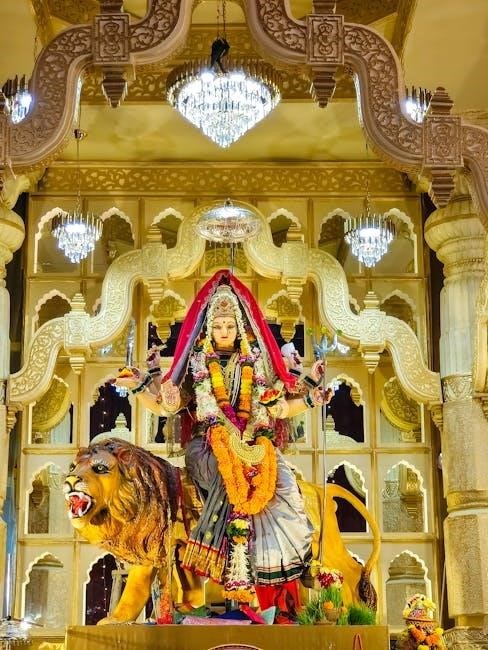
Theological and Liturgical Significance
The Divine Liturgy holds profound theological and liturgical significance as the central Eucharistic worship service‚ reflecting the Orthodox Church’s belief in the Real Presence and communal unity in worship․
5․1․ Role of the Priest and the Congregation
The priest plays a central role as the spiritual leader‚ consecrating the Eucharist and guiding the congregation through the liturgical rites․ The congregation actively participates by singing hymns‚ reciting prayers‚ and responding to the priest’s chants‚ embodying the communal nature of worship․ In a Greek-English PDF‚ both languages are harmonized to ensure accessibility for diverse congregants‚ preserving tradition while fostering unity․ The priest’s role is sacramental‚ while the congregation’s involvement reflects the liturgy’s communal essence‚ emphasizing the Church as the Body of Christ․ This balance highlights the liturgy’s theological depth and its call to spiritual participation for all believers․
5․2․ Sacramental Elements
The Divine Liturgy is rich in sacramental elements‚ with the Eucharist at its core․ The bread and wine‚ transformed through prayer and consecration‚ become the Body and Blood of Christ‚ uniting believers with God․ The Greek-English PDF highlights these sacred rites‚ ensuring accessibility for all․ The preparation of the gifts‚ the epiclesis‚ and the communion are central sacramental moments․ These elements emphasize the liturgy’s mystical nature‚ bridging heaven and earth․ The PDF format preserves the sacramental integrity while offering linguistic diversity‚ allowing worshippers to engage deeply with the liturgy’s spiritual and theological dimensions․
5․3․ Spiritual Preparation for Participants
Spiritual preparation is essential for fully engaging in the Divine Liturgy․ Participants are encouraged to pray‚ fast‚ and reflect on their faith beforehand․ The Greek-English PDF provides bilingual resources‚ such as prayers and hymns‚ to aid in this preparation․ Reading the appointed scriptures and attending Vespers can deepen one’s spiritual readiness․ Fasting‚ as prescribed‚ helps focus the mind and heart on worship․ Examining one’s conscience and seeking forgiveness fosters a humble and repentant spirit․ These practices ensure that worshippers approach the liturgy with reverence and openness to God’s grace․ Proper preparation enhances the spiritual experience‚ making the liturgy a transformative encounter with the divine․
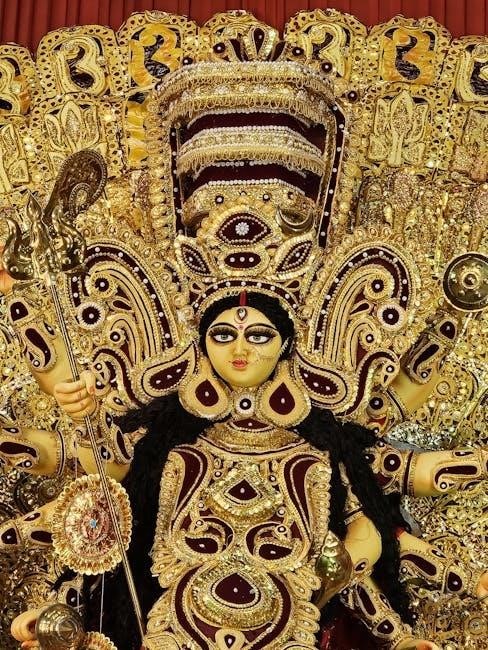
Resources for the Divine Liturgy

Official books‚ Greek-English PDFs‚ and study guides are vital resources for understanding and participating in the Divine Liturgy‚ supporting both Greek and English-speaking congregations effectively․
6․1․ Official Church Publications
Official Church publications are essential resources for the Divine Liturgy‚ offering authoritative texts in Greek and English․ These include liturgical books‚ service guides‚ and hymnals‚ ensuring accuracy and tradition․ The Greek-English PDF versions provide side-by-side translations‚ aiding bilingual worship․ Official texts are approved by Church authorities‚ maintaining liturgical integrity․ They include the Liturgy of St․ John Chrysostom‚ St․ Basil‚ and special services․ These resources are widely used in parishes‚ blending sacred tradition with modern accessibility․ They are invaluable for priests‚ chanters‚ and faithful‚ preserving the richness of Orthodox worship while catering to diverse linguistic needs․ Such publications ensure unity in worship across Greek and English-speaking communities․
6․2․ Online PDF Versions
Online PDF versions of the Divine Liturgy in Greek and English are widely accessible‚ offering convenience for worshippers․ These digital resources are often available on official church websites‚ ensuring authenticity and ease of access․ PDFs provide a clear‚ side-by-side format‚ making it easy to follow the liturgy in both languages․ They are ideal for personal use‚ study‚ or distribution within parishes․ Many PDFs are free to download‚ catering to a global audience․ This format also supports environmental sustainability by reducing paper usage․ When sourcing online‚ it’s important to verify the PDF’s accuracy and reliability‚ ensuring it aligns with traditional liturgical practices․ Online versions are a valuable tool for modern worshippers․
6․3․ Commentaries and Study Guides
Commentaries and study guides for the Divine Liturgy in Greek and English PDFs are invaluable resources for deepening understanding․ These materials offer detailed explanations of the liturgy’s structure‚ rituals‚ and theological significance․ Many guides provide historical context‚ scriptural references‚ and insights into the prayers and hymns․ They are particularly useful for those seeking to engage more deeply with the liturgical text․ Available in both Greek and English‚ these resources cater to diverse linguistic and cultural backgrounds․ Study guides often include questions and reflections‚ making them ideal for personal or group study․ They serve as a bridge between tradition and modern practice‚ enriching the spiritual experience of participants․ These resources are widely available online‚ often as free PDF downloads․
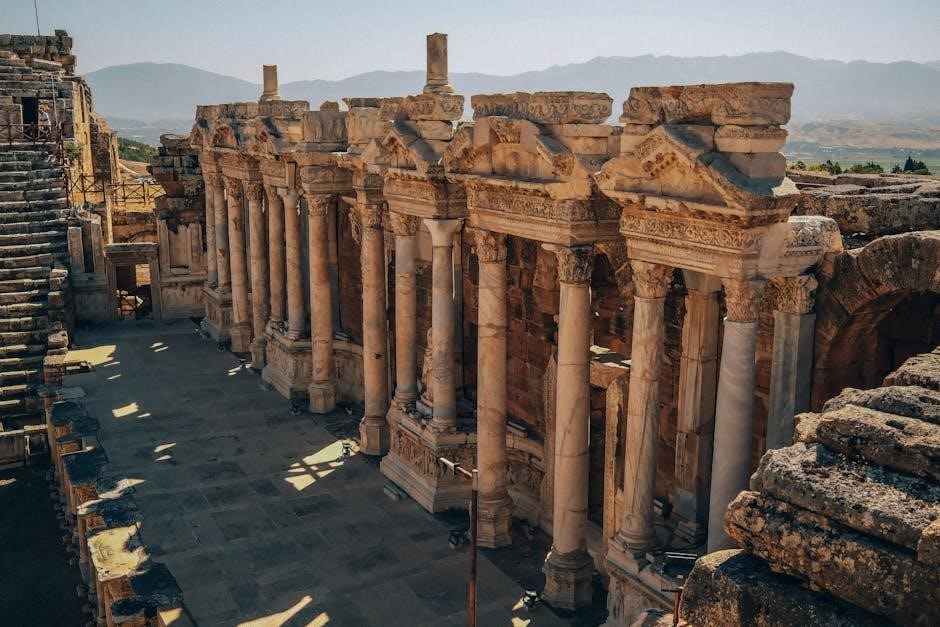
Cultural and Linguistic Considerations
The Divine Liturgy in Greek and English PDF reflects the balance between preserving Hellenic cultural heritage and adapting to modern‚ multilingual congregations‚ ensuring accessibility and unity․
7․1․ Preserving Tradition in Modern Times
The Divine Liturgy in Greek and English PDF serves as a vital tool for preserving the rich theological and cultural heritage of the Orthodox faith․ By maintaining the original Greek text alongside its English translation‚ the PDF honors the liturgical traditions passed down through centuries․ This bilingual approach ensures that the spiritual and historical essence of the liturgy remains intact‚ even as it adapts to the needs of modern‚ diverse congregations․ The side-by-side format fosters a deeper appreciation for the Hellenic roots of the liturgy while making it accessible to English-speaking worshippers‚ bridging the gap between tradition and contemporary practice․ This balance is essential for maintaining continuity and unity within the Church․
7․2․ Bridging Greek and English-Speaking Communities
The Divine Liturgy in Greek and English PDF acts as a bridge between Greek and English-speaking communities‚ fostering unity and understanding․ By providing both languages side by side‚ it enables worshippers from diverse linguistic backgrounds to participate fully in the liturgy․ This bilingual format is especially valuable for younger generations who may be more comfortable with English‚ ensuring they remain connected to their spiritual heritage․ It also facilitates intergenerational worship‚ allowing families to pray together seamlessly․ This resource not only preserves tradition but also promotes inclusivity‚ helping to build a cohesive community that transcends language barriers while maintaining the richness of the Orthodox faith․
7․3․ The Role of Music and Chant
Music and chant play a vital role in the Divine Liturgy‚ serving as a means to express reverence‚ unity‚ and spiritual devotion․ Traditional Byzantine chants‚ often sung in Greek‚ are integral to the liturgical experience‚ evoking a sense of timelessness and connection to the early Church․ In bilingual Greek and English PDFs‚ these chants are sometimes translated or adapted to accommodate English-speaking worshippers‚ ensuring accessibility while preserving the liturgy’s musical heritage․ The interplay of melody and text enhances the emotional and spiritual impact of the service‚ fostering a deeper engagement with the sacred rites․ Music bridges cultural divides‚ uniting congregations in worship and reinforcing the universal message of the Orthodox faith․
The Role of the Church in Promoting the Divine Liturgy
The Church actively promotes the Divine Liturgy by providing educational resources‚ fostering spiritual growth‚ and ensuring accessibility through bilingual Greek and English PDF materials‚ enriching worship experiences․
8․1․ Educational Initiatives
The Church has implemented various educational initiatives to deepen understanding of the Divine Liturgy․ These include workshops‚ seminars‚ and online courses that explore the liturgy’s theology and practices․ By distributing Greek and English PDF resources‚ the Church ensures accessibility for bilingual congregations‚ fostering unity and preserving tradition․ Educational programs often emphasize the liturgy’s historical and spiritual significance‚ encouraging active participation․ Additionally‚ study groups and youth programs are organized to engage younger generations‚ ensuring the liturgy remains relevant and vibrant․ These efforts not only enrich individuals’ spiritual lives but also strengthen the communal worship experience‚ bridging cultural and linguistic divides within the Church․
8․2․ Liturgical Renewal Efforts
The Church has embraced liturgical renewal to revitalize the Divine Liturgy‚ ensuring its relevance while preserving sacred traditions․ Greek and English PDF resources play a crucial role in this effort‚ offering congregations a unified yet accessible worship experience․ These materials are designed to enhance participation‚ fostering a deeper connection to the liturgy’s spiritual and theological richness․ By blending traditional chants with modern translations‚ the Church aims to inspire a sense of continuity and renewal․ Such efforts ensure the Divine Liturgy remains a vibrant expression of faith‚ bridging generations and cultures while maintaining its timeless essence․ This renewal strengthens the liturgy’s impact in contemporary spiritual life․
8․3․ Interfaith Dialogue and Outreach
The Church actively promotes interfaith dialogue and outreach through the Divine Liturgy‚ using Greek and English PDF resources to share its spiritual richness․ These materials serve as bridges‚ fostering understanding and unity among diverse communities․ By providing accessible texts‚ the Church encourages participation and reflection‚ even among non-Greek speakers․ This initiative highlights the universal message of the Divine Liturgy‚ transcending cultural and linguistic barriers․ Outreach programs often incorporate these resources to educate others about Orthodox worship‚ fostering mutual respect and cooperation․ Such efforts strengthen ecumenical ties and inspire a deeper appreciation for the liturgy’s theological and spiritual significance in a global context․
The Divine Liturgy in Greek and English PDF serves as a timeless spiritual guide‚ fostering unity and understanding․ It remains a vital resource for worship and reflection․
9․1․ Final Thoughts on the Divine Liturgy
The Divine Liturgy‚ whether in Greek or English‚ remains a cornerstone of Orthodox worship․ The bilingual PDF format ensures accessibility‚ preserving the liturgy’s timeless beauty while fostering unity across linguistic and cultural divides․ By maintaining the integrity of tradition‚ it bridges generations‚ allowing faithful participation and spiritual enrichment․ This resource not only honors the past but also equips the present‚ ensuring the Divine Liturgy continues to inspire and guide believers in their journey toward God․

9․2․ Encouragement for Further Study
Exploring the Divine Liturgy in Greek and English PDF invites deeper spiritual growth and understanding․ Delve into its theological richness‚ cultural significance‚ and liturgical beauty․ By studying the bilingual text‚ one can appreciate the continuity of tradition while engaging with its timeless message․ Encourage others to embrace this resource for personal reflection and communal prayer․ The Divine Liturgy is not just a ritual but a living expression of faith‚ bridging past and present․ Embrace the opportunity to explore its depths‚ fostering a stronger connection to the Orthodox heritage and its universal truths․
9․3․ The Future of the Divine Liturgy in Greek and English
The future of the Divine Liturgy in Greek and English PDFs lies in embracing technological advancements while preserving sacred traditions․ As digital platforms expand‚ bilingual resources will become more accessible‚ fostering unity among diverse Orthodox communities․ Younger generations will benefit from interactive and educational tools that enhance understanding․ The integration of Greek and English texts ensures cultural continuity while accommodating linguistic diversity․ By promoting these resources‚ the Church can inspire deeper engagement and spiritual growth․ The Divine Liturgy’s timeless message‚ paired with modern accessibility‚ will continue to nourish the faithful globally‚ ensuring its vibrant presence for generations to come․
